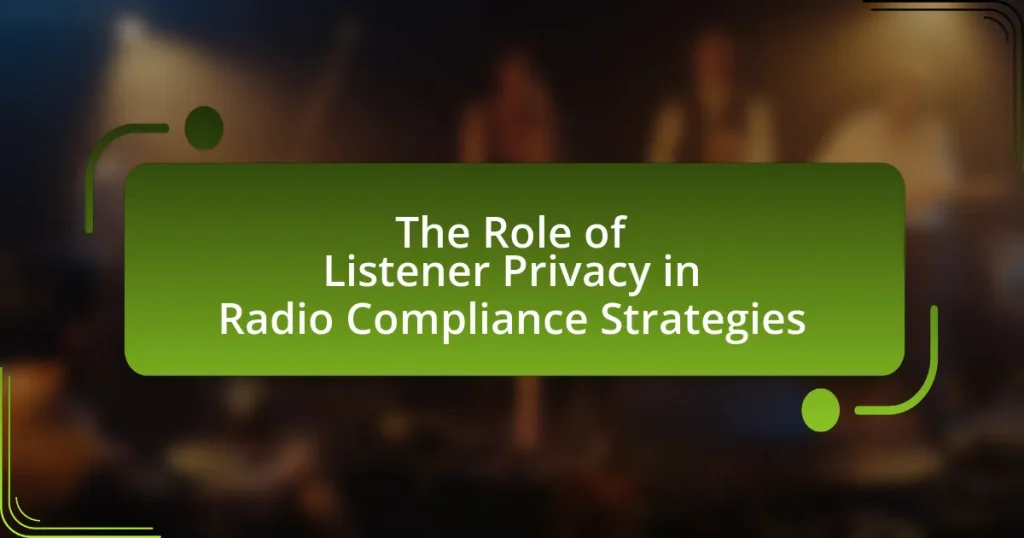The article examines the future of radio in a post-COVID world, highlighting the significant shifts towards digital integration and on-demand content consumption. It discusses the impact of the pandemic on listener behavior, including increased online streaming and podcasting, as well as the decline in traditional radio advertising revenues. The article also addresses anticipated regulatory changes that may affect content delivery and advertising, the challenges faced by radio stations, and the opportunities for innovation and community engagement moving forward. Key strategies for retaining listeners and enhancing offerings through technology and partnerships are also outlined, emphasizing the need for radio to adapt to evolving audience preferences in a competitive media landscape.

What is the Future of Radio in a Post-COVID World?
The future of radio in a post-COVID world is characterized by increased digital integration and a shift towards on-demand content. As audiences have become more accustomed to streaming services during the pandemic, traditional radio is adapting by enhancing its online presence and offering podcasts and live streaming options. According to a Nielsen report, 60% of Americans now listen to online radio, indicating a significant shift in listener behavior. This trend suggests that radio stations will increasingly focus on digital platforms to reach their audiences effectively, ensuring they remain relevant in a rapidly evolving media landscape.
How has the COVID-19 pandemic impacted the radio industry?
The COVID-19 pandemic has significantly impacted the radio industry by accelerating the shift towards digital platforms and altering listener habits. During the pandemic, many traditional radio stations experienced a decline in advertising revenue as businesses reduced marketing budgets; for instance, the Radio Advertising Bureau reported a 30% drop in ad revenue in 2020. Concurrently, there was an increase in online streaming and podcast consumption, with a Nielsen report indicating that podcast listening grew by 42% in 2020. This shift has prompted radio stations to adapt by enhancing their digital presence and exploring new revenue models, such as subscription services and partnerships with streaming platforms.
What changes in listener behavior have emerged during the pandemic?
Listener behavior has shifted significantly during the pandemic, with increased consumption of digital audio platforms and a decline in traditional radio listenership. According to a Nielsen report, 2020 saw a 30% rise in podcast listening and a 20% increase in streaming services, as audiences sought on-demand content while staying at home. Additionally, listeners have gravitated towards more localized content, reflecting a desire for community connection during isolation. This change indicates a fundamental transformation in how audiences engage with audio media, driven by the unique circumstances of the pandemic.
How have radio stations adapted their programming in response to COVID-19?
Radio stations have adapted their programming in response to COVID-19 by increasing the focus on local news, health information, and community support initiatives. This shift was driven by the need to keep listeners informed about rapidly changing health guidelines and local developments. For instance, many stations expanded their news segments and introduced special programming dedicated to COVID-19 updates, featuring expert interviews and resources for listeners. Additionally, radio stations enhanced their online presence and engagement through social media and streaming services to reach audiences who were homebound during lockdowns. This adaptation not only addressed immediate listener needs but also reinforced the role of radio as a vital source of information during the pandemic.
What regulatory changes are anticipated for the radio industry?
Anticipated regulatory changes for the radio industry include increased flexibility in licensing and content regulations to adapt to digital platforms. The Federal Communications Commission (FCC) is expected to streamline the licensing process, allowing for quicker approvals and modifications, which reflects the growing convergence of traditional and digital media. Additionally, there may be adjustments to content regulations to accommodate the rise of streaming services and podcasts, ensuring that radio remains competitive in a rapidly evolving media landscape. These changes are driven by the need to modernize regulations that have not kept pace with technological advancements and consumer behavior shifts.
What new regulations are being proposed to support radio stations?
New regulations proposed to support radio stations include increased funding for local broadcasting, enhanced access to digital platforms, and streamlined licensing processes. These measures aim to bolster the financial stability of radio stations, particularly those serving underserved communities, by providing grants and subsidies. Additionally, the Federal Communications Commission (FCC) is considering policies that would facilitate partnerships between radio stations and online streaming services, allowing for greater audience reach and revenue opportunities. These proposals are grounded in the need to adapt to changing media consumption habits and ensure the sustainability of local radio in a competitive landscape.
How might these regulations affect content delivery and advertising?
Regulations may significantly impact content delivery and advertising by imposing stricter guidelines on what can be broadcasted and how advertisements are presented. These regulations could lead to a reduction in the diversity of content available, as broadcasters may prioritize compliance over creativity. For instance, regulations that limit the amount of advertising during programming can affect revenue streams for radio stations, potentially leading to fewer resources for content creation. Additionally, compliance with new standards may require technological upgrades, which could divert funds from other areas, further influencing the type of content delivered. Historical data shows that similar regulations in other media have resulted in shifts in programming strategies, often prioritizing safer, more compliant content over innovative or niche offerings.

What are the key challenges facing radio in a post-COVID landscape?
The key challenges facing radio in a post-COVID landscape include declining advertising revenues, increased competition from digital platforms, and changing listener habits. Advertising revenues have dropped significantly as businesses reassess their marketing strategies in the wake of the pandemic, leading to budget cuts in traditional media. Additionally, digital platforms such as streaming services and podcasts have gained popularity, drawing audiences away from traditional radio. According to a Nielsen report, radio listenership has shifted, with younger demographics increasingly favoring on-demand audio content, which further complicates radio’s ability to retain its audience. These factors collectively pose significant hurdles for radio stations as they navigate the evolving media landscape.
How is competition from digital platforms influencing radio?
Competition from digital platforms is significantly influencing radio by driving traditional broadcasters to adapt their content and delivery methods. As streaming services and podcasts gain popularity, radio stations are increasingly incorporating on-demand content and digital streaming options to retain listeners. According to a 2021 Nielsen report, 62% of Americans listen to online radio, highlighting the shift in audience preferences. This competition compels radio to innovate, leading to collaborations with digital platforms and the development of mobile apps to enhance accessibility and engagement.
What strategies can radio stations employ to retain listeners?
Radio stations can retain listeners by implementing targeted content strategies, engaging with audiences through social media, and enhancing listener experiences. Targeted content strategies involve curating playlists and programs that resonate with specific demographics, which can increase listener loyalty; for instance, stations that analyze listener data to tailor their offerings have seen a rise in audience retention rates. Engaging with audiences through social media allows stations to create a community around their brand, fostering interaction and feedback, which can lead to a more dedicated listener base. Enhancing listener experiences through promotions, contests, and exclusive content can also incentivize listeners to stay tuned, as evidenced by stations that report higher engagement levels when they offer unique experiences or rewards.
How can radio leverage technology to enhance its offerings?
Radio can leverage technology to enhance its offerings by integrating digital streaming platforms and utilizing data analytics for audience engagement. Digital streaming allows radio stations to reach a global audience, increasing listenership beyond geographical limitations. For instance, platforms like Spotify and Apple Music have shown that streaming services can significantly boost audience numbers, with Spotify reporting over 400 million users as of 2021. Additionally, data analytics enables radio stations to understand listener preferences and tailor content accordingly, improving listener satisfaction and retention. According to a Nielsen report, personalized content can increase listener engagement by up to 30%. Thus, by adopting these technologies, radio can modernize its offerings and remain competitive in the evolving media landscape.
What role does government policy play in shaping the future of radio?
Government policy plays a crucial role in shaping the future of radio by establishing regulations that govern broadcasting standards, licensing, and content diversity. These policies influence the operational landscape for radio stations, determining how they can adapt to technological advancements and audience preferences. For instance, the Federal Communications Commission (FCC) in the United States has implemented policies that promote localism and minority ownership, which can enhance the representation of diverse voices in radio programming. Additionally, government initiatives aimed at supporting digital transition and funding for public broadcasting can significantly impact the sustainability and innovation within the radio industry.
What are the implications of deregulation for the radio industry?
Deregulation in the radio industry leads to increased competition and consolidation among broadcasters. This shift allows larger companies to acquire smaller stations, resulting in fewer independent voices and potentially homogenized content. For instance, after the Telecommunications Act of 1996, the number of radio station owners decreased significantly, with a few corporations controlling a large share of the market. This consolidation can diminish local programming and reduce diversity in radio content, as companies prioritize profitability over community-focused broadcasting.
How can advocacy groups influence regulatory changes?
Advocacy groups can influence regulatory changes by mobilizing public opinion, lobbying policymakers, and providing expert information to support their positions. These groups often conduct campaigns that raise awareness about specific issues, thereby shaping the narrative and encouraging public discourse. For instance, the National Association of Broadcasters has historically lobbied for favorable regulations in the broadcasting sector, demonstrating the effectiveness of organized advocacy in influencing legislative outcomes. Additionally, research shows that advocacy efforts can lead to significant shifts in regulatory frameworks, as seen in the telecommunications industry, where consumer advocacy groups successfully pushed for net neutrality regulations.

What opportunities exist for radio in a post-COVID world?
Radio has significant opportunities in a post-COVID world, particularly through increased digital integration and audience engagement. The pandemic accelerated the shift towards online streaming and podcasting, allowing radio stations to reach broader audiences beyond traditional FM/AM frequencies. According to a Nielsen report, podcast listening increased by 54% during the pandemic, indicating a growing appetite for audio content. Additionally, radio can leverage social media platforms to enhance listener interaction and community building, fostering loyalty and expanding its reach. These trends suggest that radio can adapt and thrive by embracing technology and evolving listener preferences in the post-COVID landscape.
How can radio stations innovate to attract new audiences?
Radio stations can innovate to attract new audiences by leveraging digital platforms and interactive content. By integrating streaming services, podcasts, and social media engagement, radio stations can reach younger demographics who prefer on-demand content. For instance, according to a 2021 Nielsen report, 54% of U.S. adults aged 18-34 listen to podcasts, indicating a significant opportunity for radio stations to create complementary podcast content that resonates with this audience. Additionally, incorporating listener feedback through real-time polls and social media interactions can enhance audience engagement and foster a sense of community, making the listening experience more interactive and appealing.
What partnerships can radio form to expand its reach?
Radio can form partnerships with digital platforms, local businesses, and community organizations to expand its reach. Collaborating with digital platforms like streaming services allows radio stations to access broader audiences and integrate their content into online ecosystems. Partnerships with local businesses can enhance community engagement and provide mutual promotional opportunities, while alliances with community organizations can help radio stations tap into niche audiences and foster local support. These strategies are supported by the increasing trend of cross-platform content consumption, where audiences seek diverse media experiences.
How can radio enhance community engagement post-pandemic?
Radio can enhance community engagement post-pandemic by providing a platform for local voices and fostering real-time interaction among community members. This medium allows for the dissemination of important information, such as health guidelines and local events, which is crucial in rebuilding community trust and cohesion after the pandemic. According to a 2021 report by the Pew Research Center, 83% of Americans believe that local radio is important for their community, highlighting its role in connecting residents and promoting local initiatives. Additionally, radio can facilitate discussions on pressing issues, encouraging community participation and feedback, thus strengthening social ties and collective resilience.
What best practices should radio stations adopt moving forward?
Radio stations should adopt a multi-platform approach to reach audiences effectively. This involves integrating traditional broadcasting with digital platforms, including social media and streaming services, to enhance listener engagement. According to a Nielsen report, 93% of Americans still listen to radio weekly, but digital platforms are increasingly important, with over 60% of listeners using online streaming services. By diversifying content delivery methods, radio stations can capture a broader audience and adapt to changing listener habits. Additionally, investing in data analytics can help stations understand audience preferences and tailor programming accordingly, ensuring relevance in a competitive media landscape.
How can radio stations effectively measure listener engagement?
Radio stations can effectively measure listener engagement through a combination of audience surveys, digital analytics, and social media interaction metrics. Audience surveys provide direct feedback on listener preferences and satisfaction, while digital analytics track online streaming numbers, app usage, and website visits, offering quantitative data on listener behavior. Social media interaction metrics, such as likes, shares, and comments, reflect listener engagement with content and programming. According to a 2021 Nielsen report, stations that utilize these methods can achieve a more comprehensive understanding of their audience, leading to improved programming and targeted advertising strategies.
What are the key elements of a successful post-COVID radio strategy?
The key elements of a successful post-COVID radio strategy include audience engagement, digital integration, and adaptive content delivery. Audience engagement is crucial as it fosters listener loyalty and interaction, which can be enhanced through social media platforms and listener feedback mechanisms. Digital integration is essential, as radio stations must leverage online streaming and podcasting to reach broader audiences; according to a Nielsen report, 62% of Americans listen to online radio weekly. Adaptive content delivery involves tailoring programming to meet the evolving preferences and needs of listeners, which can be informed by data analytics and audience insights. These elements collectively ensure that radio remains relevant and competitive in a changing media landscape.



